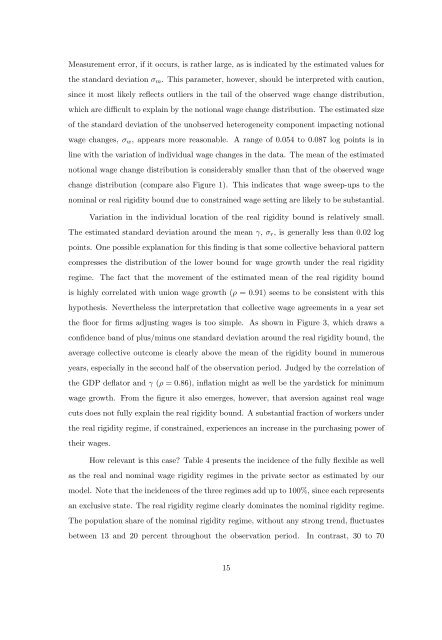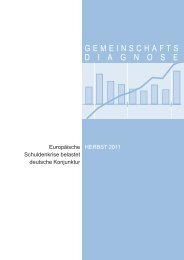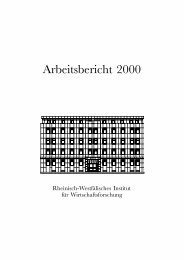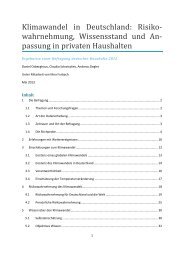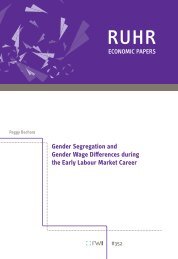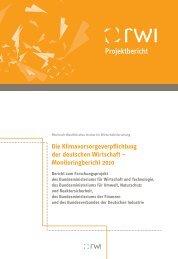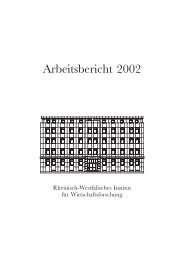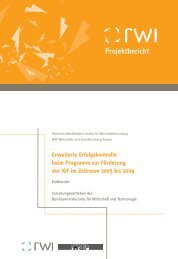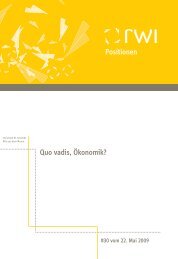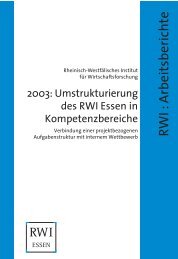RW I:Discussion Papers - Rheinisch-Westfälisches Institut für ...
RW I:Discussion Papers - Rheinisch-Westfälisches Institut für ...
RW I:Discussion Papers - Rheinisch-Westfälisches Institut für ...
You also want an ePaper? Increase the reach of your titles
YUMPU automatically turns print PDFs into web optimized ePapers that Google loves.
Measurement error, if it occurs, is rather large, as is indicated by the estimated values for<br />
the standard deviation σ m . This parameter, however, should be interpreted with caution,<br />
since it most likely reflects outliers in the tail of the observed wage change distribution,<br />
which are difficult to explain by the notional wage change distribution. The estimated size<br />
of the standard deviation of the unobserved heterogeneity component impacting notional<br />
wage changes, σ w , appears more reasonable. A range of 0.054 to 0.087 log points is in<br />
line with the variation of individual wage changes in the data. The mean of the estimated<br />
notional wage change distribution is considerably smaller than that of the observed wage<br />
change distribution (compare also Figure 1). This indicates that wage sweep-ups to the<br />
nominal or real rigidity bound due to constrained wage setting are likely to be substantial.<br />
Variation in the individual location of the real rigidity bound is relatively small.<br />
The estimated standard deviation around the mean γ, σ r , is generally less than 0.02 log<br />
points. One possible explanation for this finding is that some collective behavioral pattern<br />
compresses the distribution of the lower bound for wage growth under the real rigidity<br />
regime. The fact that the movement of the estimated mean of the real rigidity bound<br />
is highly correlated with union wage growth (ρ =0.91) seems to be consistent with this<br />
hypothesis. Nevertheless the interpretation that collective wage agreements in a year set<br />
the floor for firms adjusting wages is too simple. As shown in Figure 3, which draws a<br />
confidence band of plus/minus one standard deviation around the real rigidity bound, the<br />
average collective outcome is clearly above the mean of the rigidity bound in numerous<br />
years, especially in the second half of the observation period. Judged by the correlation of<br />
the GDP deflator and γ (ρ =0.86), inflation might as well be the yardstick for minimum<br />
wage growth. From the figure it also emerges, however, that aversion against real wage<br />
cuts does not fully explain the real rigidity bound. A substantial fraction of workers under<br />
the real rigidity regime, if constrained, experiences an increase in the purchasing power of<br />
their wages.<br />
How relevant is this case? Table 4 presents the incidence of the fully flexible as well<br />
as the real and nominal wage rigidity regimes in the private sector as estimated by our<br />
model. Note that the incidences of the three regimes add up to 100%, since each represents<br />
an exclusive state. The real rigidity regime clearly dominates the nominal rigidity regime.<br />
The population share of the nominal rigidity regime, without any strong trend, fluctuates<br />
between 13 and 20 percent throughout the observation period. In contrast, 30 to 70<br />
15


